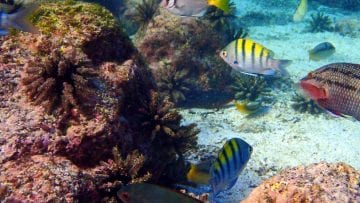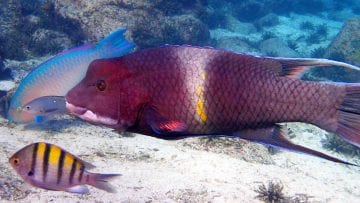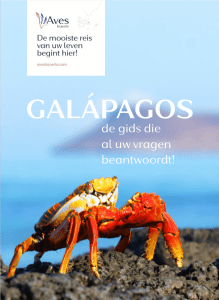San Cristóbal
A wonderful island to stay for a few days
Highlights
red footed boobie, large colonies of sea lions, very good snorkeling locations, beautiful views
Explore and experience
The first island where Charles Darwin arrived and perhaps your first introduction to the archipelago as well. San Cristóbal is home to the second airport of the islands (Baltra is the other option). From the small port town of Puerto Baquerizo Moreno (also the capital of the Galápagos, although Puerto Ayora on Santa Cruz is larger) various expedition cruises and day trips depart. For example day trips to Española depart from San Cristóbal. The largest freshwater lake in the archipelago, El Junco, is located in the highlands.
At San Cristóbal and its surroundings there is much to discover! The National Park has designated no fewer than 16 locations on land and 7 diving/snorkelling locations. We list the most important ones below.
Centro de Interpretación
This interesting visitor center is located in Puerto Baquerizo Moreno. It was established in 1998 by the Government of Spain through the Spanish Agency for International Development Cooperation (AECID), in collaboration with the management of Galápagos National Park and the support of the Charles Darwin Foundation. The exhibition takes you through the history of the islands, in their natural and human context. In addition, attention is paid to an explanation about nature conservation.
Galapaguera Natural
A site where you can observe various endemic species native to San Cristóbal. You may see the “Geochelone elephantopus San Chatamensis” giant tortoise, the San Cristóbal mocking bird and the Microlophus bivittatus lava lizard. The beach at this visitor center is large and serves as a breeding ground for marine turtles. In the months of January to May it is common to find the traces of the females who have climbed the sand dunes to lay their eggs.
Galapaguera de Cerro Colorado
In the southeast of San Cristóbal, about 40 minutes’ drive from Puerto Baquerizo Moreno, lies this interesting and beautiful reserve for giant tortoises. The center is built to protect and strengthen the population of the giant tortoise on the island. San Cristóbal once had two types of endemic tortoises, one of which became extinct over the centuries because whalers gladly took them for food on board. The visitor center explains the natural history of the population of giant tortoises on the island, and the relationship and differences between the tortoises of San Cristóbal and the other tortoises of the archipelago in terms of origin and evolution. In addition to the interesting giant tortoises, you will also find various species of native and endemic plants in this area. It is one of the few places where you can see the Calandrinia Galapagosa, endemic to San Cristobal. These plant species also attract a rich population of birds, such as the mocking bird, the small tree finch and various canary species.
Isla Lobos
Isla Lobos is named after the sea lions colony that likes to rest and play on its rocks. In addition, many birds nest here, such as the brown pelican, lava gulls, various finches, blue-footed boobies and the beautiful yellow warbler. During snorkelling you will be accompanied by marine turtles and you have a good chance that a young sea lion will choose you as a playmate.


León Dormido
A very good place for snorkelling and diving. Many seabirds live on the steep walls. However, the ocean reveals its most beautiful secrets here: many colourful coral fish, hammerhead sharks and the Galápagos shark are often seen here. With a little luck, you will sometimes be accompanied by rays and marine turtles.
Cerro Brujo
Cerro Brujo is located on the north coast of the island of San Cristobal. With a wet landing you will arrive at a white sandy beach where you will find pelicans, blue-footed boobies, sea lions and marine iguanas.Cerro Brujo (translated into English: Wizard’s Hill) is an eroded tuff cone, composed of a’a lava in various places. Various herons live in the lagoon at Cerro Brujo. From the beach you have a beautiful view of León Dormido (an impressive rock formation off the coast). Snorkelling in the turquoise waters in front of Cerro Brujo is a true pleasure with a rich marine life.
Punta Pitt
With a wet landing you set foot on the olivine beach of Punta Pitt, located on the eastern edge of the island of San Cristóbal. The path runs through a fascinating landscape of eroded tuff formations and gives you an impressive view of your surroundings in various places. Punta Pitt is unique because it is the only place where the three types of boobies come together: the blue-footed, nazca and red-footed boobie. The latter in particular is special because it can only be found in the extreme north on Genovesa (the largest breeding colony, where they also live together with the Nazca boobie) and on a small island near Floreana in the extreme south. In addition to the spectacle of the boobies, you can also enjoy the large and small frigate birds.
La Loberia
This beautiful coral sand beach with a large colony of sea lions is not far from Puerto Baquerizo Moreno. You reach this beach via a short walk over lava rock where many marine iguanas warm up in the sun. You can also snorkel beautifully in the bay.
Playa Ochoa
Playa Ochoa is located north of the island of San Cristobal, about 30 minutes from Puerto Baquerizo Moreno. In this area there is a significant colony of Galápagos sea lions. It is great to walk on the beach, swim and snorkel here. Playa Ochoa is a site used by cruise ships that begin or end their trips on the island of San Cristóbal.
Laguna El Junco
The Laguna El Junco is the largest and practically only permanent freshwater lake in the archipelago. It covers an area of 60,000 m2. The lagoon is formed by a small crater that in turn is located in a large crater. The name of the lagoon comes from the “Junco” plant species that is common in this area. You have a breathtaking view over the lagoon, the rich bird life and the surrounding landscape.
Cerro Tijeretas
A walk of approximately 2 hours takes you through the area of Cerro Tijeretas, a hill near Puerto Baquerizo Moreno. During your walk you have some beautiful viewpoints. Along the way you will come across an American World War II cannon that was used by the Ecuadorian navy for military exercises in the early 1970’s. Another vantage point offers panoramic views of the island’s north coast, from where you can see León Dormido and Cerro Mundo. At the next vantage point is a statue of Charles Darwin in honor of his visit to San Cristóbal.
Punta Carola
Punta Carola is a beach located in the northwest of Puerto Baquerizo Moreno. The beach covers an area of approximately 300 meters, which consists of dry forest vegetation.
On the beach there is a large colony of sea lions among the vegetation and marine iguanas are present on the rocks.
Puerto Chino
About 25 km from Puerto Baquerizo Moreno and a few kilometers from the Crianza Center next to Cerro Colorado is Puerto Chino. The access is by land towards a gravel mine, from where you walk a 1.5 km path over lava rock. At the end you will come to this beautiful white beach. Here you can see the dry vegetation that is characteristic of San Crisóbal. From the beach you can observe birds such as the frigate bird and the blue-footed boobie.
Puerto Grande
Puerto Grande is located next to the island of León Dormido on the north coast of San Cristóbal. You will find a wonderful beach here. The popular stories suggest that treasures are buried here, but attempts to find them have not been successful to date.
Manglecito
The Manglecito consists of two areas: the mangrove area and the beach area. The mangrove zone is an ideal place for bird watching, while you can sunbathe and swim on the beach.
Back to overview